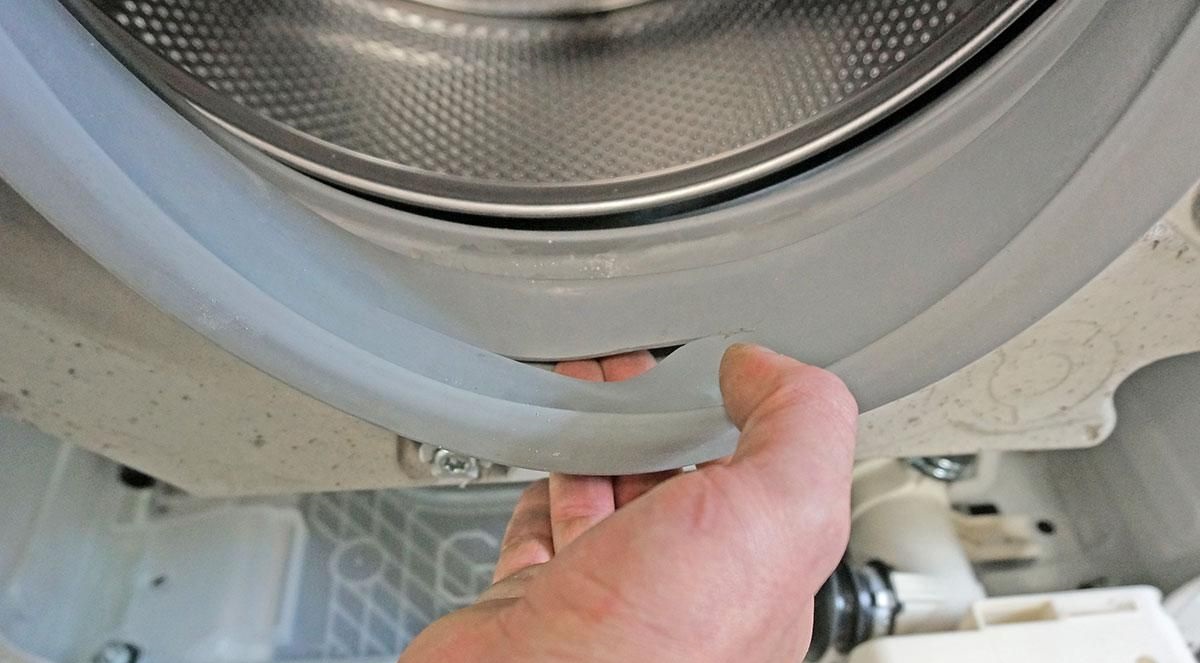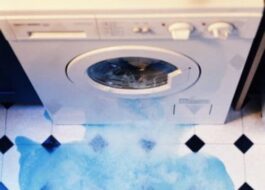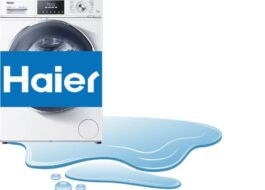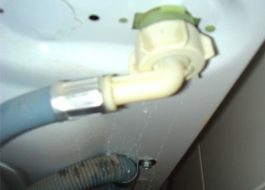LG washing machine is leaking from below
 The list of fairly common breakdowns of LG washing machines includes their leakage. The leak can be barely noticeable, or it can be threatening. In any case, if an LG machine leaks from below during washing, the problem should be solved immediately. You can invite a specialist who will understand the causes of the leak, or try to fix the breakdown yourself. We hope the information presented will help you in repairing your “home assistant”.
The list of fairly common breakdowns of LG washing machines includes their leakage. The leak can be barely noticeable, or it can be threatening. In any case, if an LG machine leaks from below during washing, the problem should be solved immediately. You can invite a specialist who will understand the causes of the leak, or try to fix the breakdown yourself. We hope the information presented will help you in repairing your “home assistant”.
Where and why did it leak?
Before repairing your washing machine, be sure to turn off the power. This will ensure safety when working with equipment.
Pay attention to at what stage of the washing machine the machine leaked; this information will greatly facilitate diagnostics and allow you to quickly understand the causes of the breakdown.
Afterwards, inspect the washer from all sides, if necessary, tilt the device to examine the bottom. It would be useful to remove the rear or side wall of the case, so the inspection of the machine will be more complete. It is important to determine the location of the leak as accurately as possible, this will help in further work.
Perhaps the SMA tank is leaking, then we can talk about the need for serious equipment repairs. The drain hose is probably leaking, and then the solution to the problem is simply replacing it. If it is leaking from under the door, it is probably due to a damaged hatch seal. Therefore, it is so necessary to determine the location of the leak and plan the progress of work based on this. In most cases, the machine leaks from below due to:
- violation of equipment operation rules;
- use of low-quality detergents for washing;
- manufacturing defects made during the manufacture of units and components;
- failure of any element of the system.
Let's figure out what the causes of the malfunction are and where to start diagnosing. We'll tell you what actions to take to cope with a leak in a given situation.
Filter and drain hose connection
A leak from the bottom of an automatic machine does not always indicate a malfunction of any element of the system. This is often caused by a common user error. If some time after starting the wash you find water on the floor, check whether the dust filter lid is tightly screwed on and whether the emergency water drain hose is tucked into place. This advice will be especially relevant if the day before you cleaned the washer’s garbage filter. Perhaps you simply did not secure the element tightly.
If the garbage filter cap is screwed all the way down, you should inspect the connection between the drain pump and the drain hose. To do this you will have to look under the bottom of the machine. The connection of these two elements often leaks due to the loosening of the fixing clamp or the appearance of cracks in the fitting. Sometimes it is enough to treat the cracked area with a waterproof sealant. Although it is much safer to immediately replace the entire cochlea.
Dispenser and spigot
Although water collects under the washing machine, the source of the leak may be much higher. Inspect the detergent dispenser. Perhaps the tray is very dirty, and this is what leads to overflow. The water simply gets stuck in the dispenser, as it cannot be directed further, and flows out onto the floor. You should inspect the dispenser inside and out, carefully examining its corners, because most often the leak appears there.
The powder receptacle is easy to “bring to clean water.” You should fill its sections with water, thoroughly wipe the bottom with a rag so that it remains dry, and observe. If the tray is really leaking, you will see water start to flow.
The pipe can fail even on relatively new LG machines after one or two years of operation. This is due to unscrupulous assemblers who are trying to save money on equipment components.
If the machine starts to leak just as water is being added to the system, most likely the reason lies in the pipe.
To carry out an accurate diagnosis, you should remove the upper wall of the washing machine body.
It happens that it is the drain pipe directed from the machine tank to the pump that begins to leak. It’s not difficult to check this guess; just tilt the automatic machine and look inside the body from below. Perhaps the reason lies in the filler pipe of the washing equipment. You can inspect it by removing the front panel of the case and examining the connection area.
It is better to generously coat the junction of the pipes with other elements with moisture-resistant glue, this will help eliminate leaks.
Tank or hatch rubber
A crack in the tank is the most unpleasant reason for an LG washing machine to leak. In the vast majority of cases, it is impossible to simply repair the hole; it is necessary to install a new tank, and such repairs will cost the owner a pretty penny. A leak in the tub may occur if you wash your shoes frequently. Cracks also form due to foreign sharp objects getting inside: bra underwire, nails, paper clips, buttons, etc.
The tank may also leak due to defects made by the manufacturer.In any case, it is necessary to completely disassemble the automatic washing machine, remove the tank and inspect the hole on its surface. It is better to carry out such repairs under the guarantee of a specialist.
If water is leaking from under the door, the sealing lip is likely damaged. The rubber gasket can be repaired by treating the crack with waterproof glue or using a special patch. Also, the cuff can be completely replaced, the part costs little, and the process of reinstalling it is quite clear.
To prevent damage to the hatch cuff, make sure that items that are so often forgotten in pockets do not fall into the washer drum: coins, nails, paper clips, etc.
Algorithm for finding and fixing the problem
If you decide to fix the leak on your own, without resorting to the help of a specialist, you should act with extreme caution so as not to worsen the situation. If the washing machine is under warranty, it is better to contact a service center rather than try to repair the equipment yourself. So, let’s look at what actions to take to repair the equipment, depending on the location of the leak. If a leak opens from below, the action algorithm will be as follows:
- Unplug the washing machine. You must unplug the power cord from the outlet very carefully, making sure that the water does not come into contact with you. This precaution will help avoid electric shock. If it is impossible to turn off the machine from the network without contact with water, it is necessary to turn off the electricity supply in the room at the electrical panel;
- close the filling valve;
- open the hatch door and remove items from the drum. Any water remaining in the tank should be removed from the system using the emergency drain hose.The tube is located at the bottom front of the washing machine, under a special panel near the garbage filter;
- start troubleshooting. If the hoses are damaged, you can completely replace them or simply treat the leak with waterproof glue and apply a patch. If the reason lies in a defective gasket between the hose and the machine body, then a new seal should be installed. After these manipulations are completed, the washing machine is reassembled in the reverse order, and the test washing mode is started.
If it flows from the left corner, then the reason is a leaky powder receiver. Take out the dispenser, inspect it, clean it, remove blockages. Then put the dispenser in place and start the wash. It would also be a good idea to check the pressure; it may be necessary to slightly close the inlet valve to weaken the flow of water entering the system.
If the intake valve is severely damaged, you will need the help of a specialist in the field of ACV repair.
A leak in the front, from under the hatch, can be caused by a damaged cuff. You can check the integrity and elasticity of the rubber seal yourself. Open the door and carefully inspect the cuff for cracks or creases. Minor damage can be treated with glue with waterproof components or covered with special patches. It is better to replace a heavily damaged rubber cuff with a new one, otherwise the effect of gluing and patching will be short-lived.
If the machine leaks at the stage of drawing water into the system, you should inspect the inlet valve pipe. To do this, you will have to remove the top cover of the LG washing machine body and examine the element. When defects are clearly visible on the pipes, or their appearance is very different from the original, the parts will have to be replaced.
Often the filler pipe of the washing machine tank fails. See if fluid is seeping out at the joint. If yes, you should disconnect the pipe, clean the attachment point from excess glue, wipe off the water and dry the connection area. Then put the tube in its original place, having previously treated its base with a waterproof adhesive or epoxy mixture.
If the cause of the malfunction is a damaged tank, the LG automatic washing machine will have to be almost completely disassembled. It is very difficult to carry out all the actions alone, so it is better to hire an assistant for repairs. First of all, you need to lay the washer on its side and inspect it from below. Owners of machines with a vertical loading type should inspect the “insides” under the side wall. Once you are sure that the cause lies in the tank, you can begin repairs. If the leak is severe, the element will have to be replaced.
Replacing and repairing the SMA tank is a technically complex task, for which it is better to invite a specialist.
If the automatic machine begins to leak during the spin cycle, the oil seal has probably become unusable and the drum bearings have worn out. You can only gain access to damaged elements by disassembling the tank of the LG washing machine. These works are classified as complex, so if you are not sure that you can handle it, it is better to seek the help of an AMS repair specialist.
Interesting:
5 reader comments
Add a comment Cancel reply
Categories
Washing machine repair


For buyers

For users

Dishwasher

















Thank you! Your experience was useful and your advice helped eliminate the leak!
Thank you! Tips are useful!
Thank you
How to reduce the jet pressure using the inlet valve? There is splashing.
Try closing the water supply tap to the washing machine a little, I have a lot of pressure. I had the same problem, I closed the tap and everything was fine.